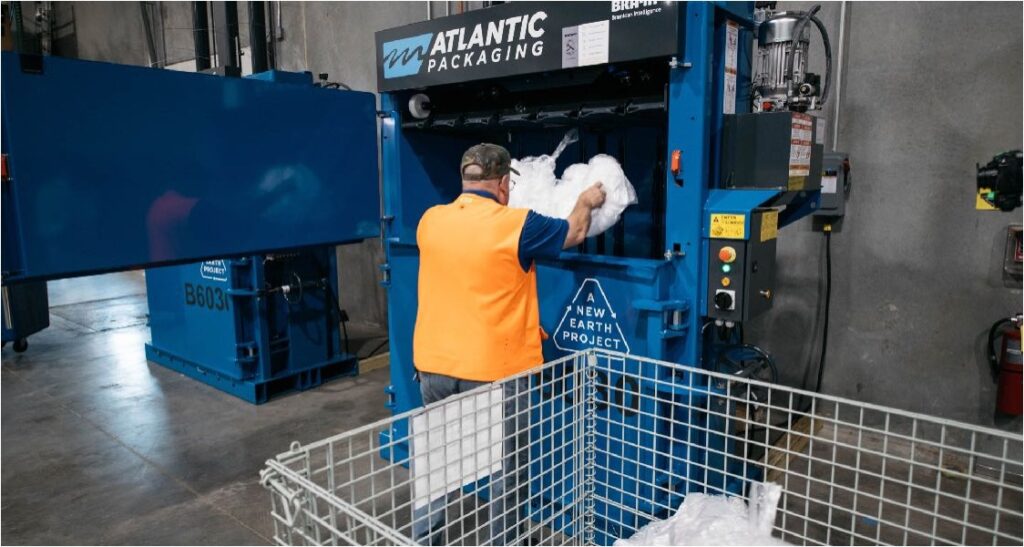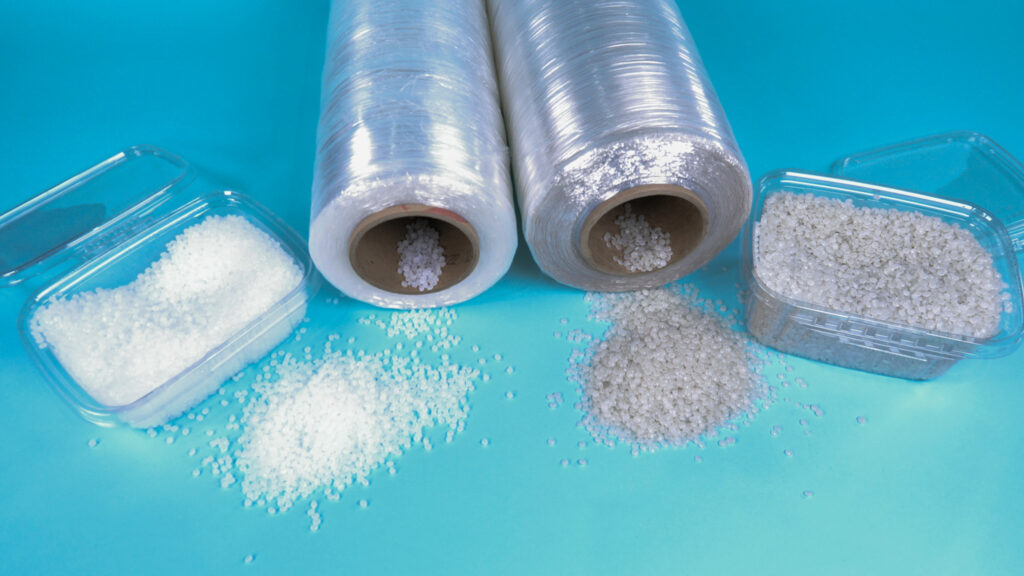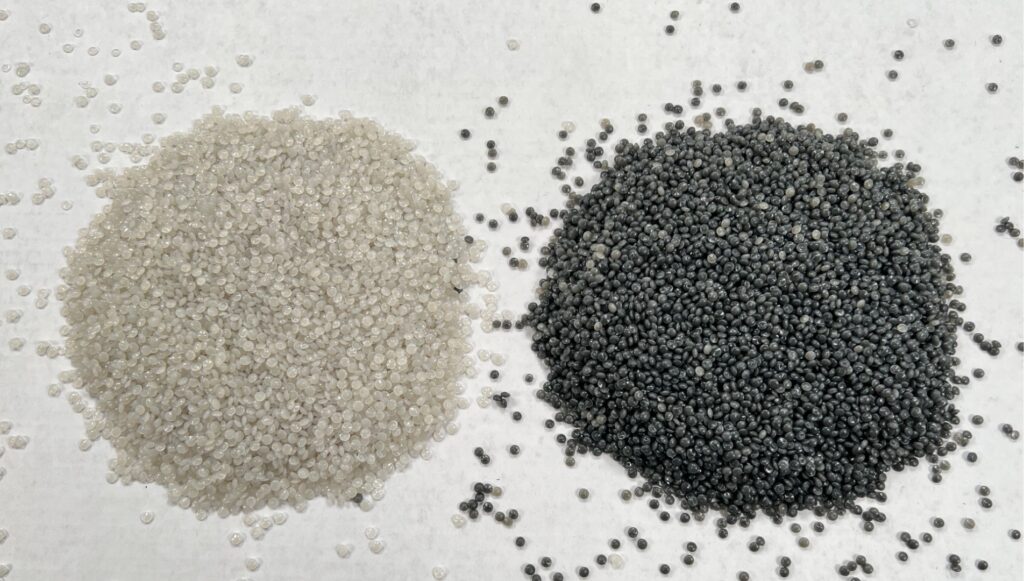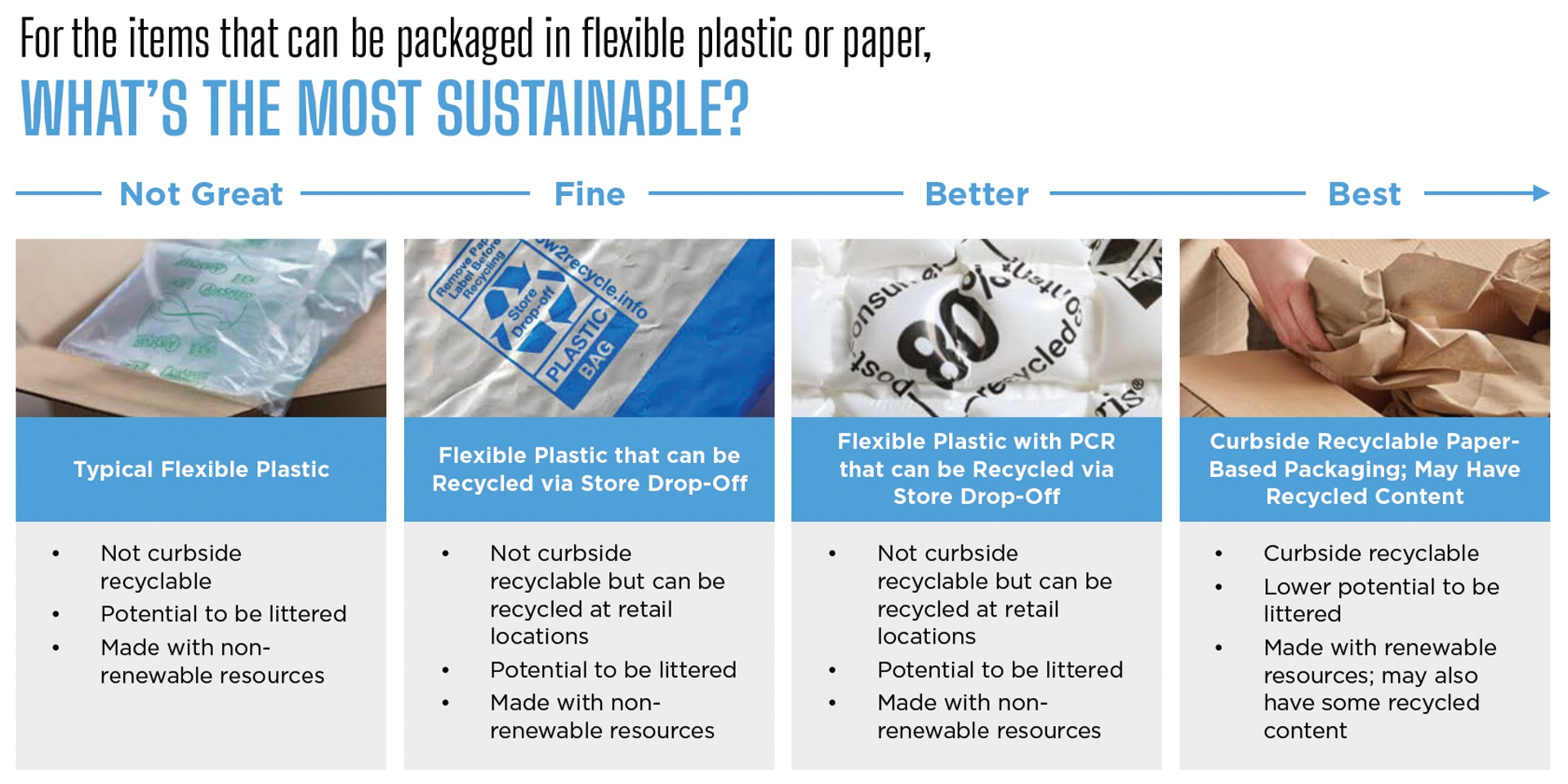Also check out our Sustainability Terms Glossary, where we’ll add key terms from each of our Deep Dives over time. Bookmark this page for future reference!
If you’ve been in the conversation about sustainable packaging at all in the last few years, you’ve seen the rise in use of recycled content in plastic packaging. But what exactly is post-consumer recycled (PCR) content, and where does it fit into the sustainable packaging landscape? Is it really sustainable? In this Deep Dive we’ll focus on PCR in plastic packaging.
Defining PCR and PIR
Post-consumer recycled content refers to materials that have already been used by consumers, recycled, and then repurposed into new products, including packaging. A piece of packaging is said to have some percentage of PCR – if for example, a plastic bag with 20% PCR was made of 20% recycled content, and the other 80% was virgin (new) content.
In the world of sustainable packaging, PCR is most commonly part of the discussion in plastics (you may also hear PCR spelled out as “post-consumer resin” in the context of plastics), but most kinds of packaging can have recycled content – glass, metal, paper, and more. For whatever reason, the term PCW (post-consumer waste) is sometimes used, especially in paper products, but the concept is the same.
What about PIR, or post-industrial recycled content? PIR basically refers to the capturing and recycling of “scrap” material on a manufacturing floor to be put into a product. For example, if a plastics manufacturer generates scrap, they can recapture that material immediately and put it back into their manufacturing process. The PIR material never actually leaves the building before it’s recycled into its original product.
Many sustainability advocates find claims of PIR content hollow, or even greenwashing. Most packaging manufacturers are collecting and recycling their production scrap as just a matter of doing good business. Because PIR never left the building, it tends to be very clean material to recycle into something else. It’s convenient and financially savvy to use PIR most of the time; it has simply become in vogue to claim “recycled content” in products, so some manufacturers are touting their use of PIR as a sustainability attribute of their product.
In contrast, PCR comes from material that has accomplished its end use by a consumer and has been collected to turn back into a product. Because PCR comes from material that is being collected by consumers, it tends to have a greater diversity of materials in it and likely has higher levels of contamination.
Why use recycled content, particularly PCR?
From an environmental sustainability lens, there are four main reasons to incorporate PCR into packaging, plastic or otherwise:
- Reducing use of virgin materials: Incorporating recycled content reduces the demand for virgin raw materials. By reusing materials that have already been extracted, processed, and used in a previous product, companies contribute to the conservation of natural resources. This is crucial for materials like paper, plastics, glass, and metals, where extraction and processing can have significant environmental impacts.
- Reducing energy use and lowering emissions: The production of recycled materials generally requires less energy compared to creating products from virgin materials. Manufacturing goods from recycled content often results in lower greenhouse gas emissions and helps conserve energy resources. This aligns with the broader goal of reducing the environmental footprint associated with industrial processes.
- Landfill avoidance and waste reduction: Incorporating recycled content promotes a circular economy by diverting materials from the waste stream and landfills. Instead of being discarded, recycled materials are given a second life, extending their usefulness and minimizing the need for new raw materials. Landfill space is limited, and excessive dumping contributes to environmental degradation and poses many long-term challenges.
- Regulatory pressures: Several states, such as Washington and California, have instituted or proposed laws that plastic products must contain a minimum percentage of recycled content. Packaging Extended Producer Responsibility (EPR) laws passed in the U.S. may also incentivize or mandate the use of PCR.
So why not just put PCR in all plastic packaging?
If only it were so easy! PCR clearly has environmental benefits, and consumers are demanding it in their packaging. However, there are challenges associated with producing and integrating PCR on a large scale.
Cost
Generally, PCR does cost more than a similar package that contains no PCR. There are specific marginal costs associated with producing a PCR product. For example, as more companies want to develop and produce products with PCR content in them, we have seen a lack of availability of PCR feedstock. This lack of availability drives up the price of materials used to make PCR. There are also costs associated with sourcing and sorting the feedstock material, handling and transporting materials, and manufacturing PCR products. In addition, there are also costs associated with the testing and development of these products. On the other hand, there is an argument to be made that PCR demands have increased as oil becomes more expensive and generally not preferred due to its negative environmental impact.
However, the upfront cost of PCR materials is not the main driver of companies deciding to make this change. The main driving force for PCR demand is its lower environmental footprint, in addition to an increased consumer desire for more sustainable products.
All of this said: part of the promise of a circular economy is that it should be cheaper to use recycled content than virgin. Our hope is that as availability improves and R&D for items with PCR in them progresses, PCR’s costs will be on par with, if not cheaper than, virgin.
Availability
In addition to an increase in demand for PCR materials by companies, the lack of availability of these materials highlights large-scale issues in our recycling system. On a broad level, there is not enough plastic of virtually every type that is properly recycled by consumers and businesses, and there can be a lot of contamination in these streams, leading to a decrease in availability. This lack of availability is cause for concern as the supply of PCR plastics today only meets about 6% of demand, which is predicted to increase by 5 million metric tons by 2030 (for more information see here).
The issue is clear: today’s recycling system is not equipped to handle the volume of plastics needed to meet this rising demand. Challenges to our current recycling model range from contamination by improperly cleaned or discarded materials, to improperly sorted materials, to limits on the types of plastics that certain facilities can process. After use, if a consumer recycles their plastic packaging, it enters a material recovery facility (MRF) to be sorted and baled with like materials. Since the quality of plastic and level of contamination can vary coming out of a MRF, it can be difficult to find a consistent stream of high-quality material to be turned into feedstock for PCR products. Additionally, typically consumers can only recycle rigid plastics #1 (PET), #2 (HDPE), and #5 (PP) through curbside systems, so PCR for other kinds of plastics, especially flexibles, is especially hard to source.
To make matters worse, virtually no consumers in the U.S. can recycle their flexible plastic packaging (FPP) through curbside systems that are headed to MRFs, in part because FPP can disrupt the recycling process by clogging machinery. Consumers can often bring their polyethylene (PE) films to store drop-off programs in the U.S., but participation is low and the typical destination for those films is into more durable products like plastic decking rather than into new films. Since it’s currently quite challenging to gather enough recycled film from consumers to turn into PCR, a lot of PCR for films is likely coming from business-to-business collection of films that does not need to go through the consumer collection and sortation process.
Ultimately, the demand for recycled plastics is quickly surpassing the supply available due to these challenges and emphasizes the need to develop more efficient recycling infrastructure and collection for materials such as FPP. The hope is that investments driven by EPR will improve recycling collection, education, and infrastructure to support clean and high-quality streams of recycled material.
Performance
PCR can differ from virgin materials in its color, transparency, texture, and durability. These differences can raise concerns for production where consistent color, transparency, and texture are crucial. These outcomes depend heavily on the quality of recycled plastic used in production and levels of contamination with other materials (inks, dirt, paper labels, non-recyclables, etc.).
While PCR can affect the performance of plastics, it can be helpful to differentiate between performance characteristics such as durability and more aesthetic differences such as transparency. Some recycled films, for instance, will have a gray-ish or spotted look but may perform completely adequately for their purpose, such as poly bags for apparel. Some potential users of PCR may shy away from integrating PCR purely for aesthetic reasons, but if the packaging still performs its intended purpose, it is likely worth questioning whether the aesthetic differences are significant enough to warrant avoiding PCR.
Ideally, a packaging product has recycled content in it and can be recycled again, creating true circularity. However, there are instances in which the addition of PCR may affect the recyclability of the product it is going into. This is also determined by the quality of recycled plastic used. A lower-quality PCR may mean a reduced ability to be recycled again, whereas a higher-quality PCR content yields a product that can be recycled multiple times after its production and use. To ensure a higher performance and quality of PCR material, investments need to be made in more effective recycling methods, such as sorting and cleansing techniques to minimize contaminants.
Food Contact Challenges
A big concern in the use of PCR has been using recycled plastics in food packaging. Specifically, concerns are raised around the possibility that some PCR products may contain contaminants that do not comply with regulations for food-contact use. The U.S. Food and Drug Administration (FDA) has established that these concerns should be addressed on a case-by-case basis and has issued general guidelines for producers and suppliers to consider when integrating PCR content into food packaging. In lieu of approval, the FDA will issue a “Letter of Non-Objection” (LNO), certifying that the collection, cleaning, and processing of the PCR materials meets their standards for food-safe plastics. Producers and suppliers must account for a variety of unknowns, including that:
- A PCR package or product may be initially produced with non-food grade feedstock
- Converters may add non-food safe additives during production
- Contaminants could migrate into food from the PCR package
Additional considerations include the possibility of microbial contamination and structural integrity, depending on the quality of the PCR content used.
The FDA oversees the premarket evaluation of the safety of substances in food packaging and has a method for reviewing recycling processes used by PCR feedstock producers. These measures help to ensure food-related PCR packaging products do not have contaminant concentrations that would migrate into food.
Despite these challenges, norms around recycling and packaging are changing, leading to a push for PCR materials by consumers and suppliers. The hope is this will lead to more investments in the technology and infrastructure to support this demand and the processing of traditionally difficult to recycle plastics. Ultimately, PCR packaging opens new opportunities to reduce the demand for raw materials and the volume of plastics sent to landfills.
If a piece of plastic packaging has PCR, is that the most sustainable option?
Like most discussions around sustainable solutions, the answer is: it depends!
When assessing the “sustainability” of a plastic packaging material, there are three main factors to look at: The material’s recyclability, its potential to be littered after use instead of recycled, and its content or make-up (e.g., is it made with renewables resources; is it helping to reduce reliance on virgin material thanks to PCR).
 As discussed, plastic packaging with PCR in it represents an improvement from completely virgin content. However, moving toward a circular economy means that we also want to be able to recycle the product again. We prefer a piece of packaging with PCR in it that remains recyclable. If the product cannot be made to be recyclable, we may prefer another option that is.
As discussed, plastic packaging with PCR in it represents an improvement from completely virgin content. However, moving toward a circular economy means that we also want to be able to recycle the product again. We prefer a piece of packaging with PCR in it that remains recyclable. If the product cannot be made to be recyclable, we may prefer another option that is.
It is important to distinguish between flexible film plastic (FFP) and rigid plastics, and how each are dealt with at their end-of-life stages. Rigid plastics have a higher recycling rate compared to FFP because they are more often curbside recyclable, whereas FFP can only be collected through store drop-off, if at all. For this reason, rigid plastics like PET, HDPE, and PP with PCR in them may be relatively sustainable options because they can be recycled again. There may also not be very good alternatives to these. For example, when packaging yogurt, a recyclable PP tub with PCR content may be the best option available today.
On the other hand, flexible plastics like LDPE with PCR in them won’t be curbside recyclable, and thus are likely to end their lives in landfills, with the small exception of some flexible films that are collected via store drop-off. While using PCR is a helpful step, from a circularity point of view, there may be more sustainable options such as paper. For example, when choosing between e-commerce mailers or air pillows, we prefer recyclable paper over a flexible poly with PCR.
Asking what option is the most sustainable depends heavily on what impact category you are optimizing for (e.g., carbon footprint, water, energy use, waste impact, etc.). We optimize for reducing waste impacts wherever we can, and ensuring we are prioritizing recyclable options drives our recommendations.
Ultimately, the “most sustainable” option from our perspective will probably be the one that is able to be collected and recycled again, instead of littered or tossed in the trash. Specifically, a material like curbside recyclable paper-based packaging with no PCR content will likely be better than a FFP with PCR content because it can be recycled after use.

